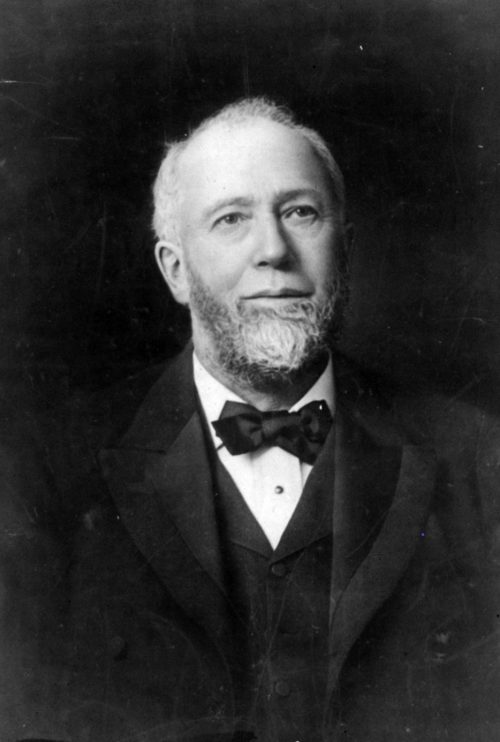A Chicago Tycoon like No Other

Gustavus Swift.

By Megan McKinney
Of all the names in the annals of Chicago history one of the most towering is that of meatpacker Gustavus Franklin Swift. He ranked with Marshall Field, Potter Palmer, George Pullman and Philip Armour. Yet he didn’t live on Prairie Avenue—too far from the Yards—nor did he lunch with his peers at The Chicago Club “millionaires’ table”; it would have been a time waster. In fact, he never bothered to join the club at all.

The Swift family’s Cape Cod farmhouse.
The tall, lean Gustavus, whose name his family and contemporaries truncated to “Stave,” was a native of Cape Cod, the eighth of William and Sally Crowell Swift’s 12 children. The Swifts’ lovely Barnstable County farmhouse was near the village of West Sandwich, now Sagamore, on the Cape, where the family was well entrenched. Stave was a sixth generation Cape Cod resident; his ancestor William Swyft is believed to have settled on the Cape in 1630—not quite as far back as the Mayflower, which dropped anchor nearby in 1620, but close.

However, this enviable connection was trumped on Stave’s mother’s side through her descent from the distinguished Mayflower passenger Elder William Brewster.

Elder William Brewster
Little wonder Prairie Avenue and the millionaire’s table held scant allure for Gustavus Swift; he knew who he was without the usual Chicago social props. He would make an immense amount of money in his lifetime, but that also meant little to him. What did propel him from early adolescence was achievement.
Like so many founders of Chicago’s great 19th century businesses, G. F. Swift was a farmer’s son; however, because soil on William Swift’s farm was sandy, producing mediocre crops, a focus was on raising and slaughtering cattle, sheep and hogs. Those are telling words.
While Marshall Field’s father had to deal with an abundance of rocks embedded in the grounds of his Massachusetts farm, across the state near Conway, it made no impression on Marshall’s later success. However, would G. F. Swift have become arguably the most successful butcher in global history if Cape Cod soil had been rich and fertile?

The slaughtering of animals became the boy’s primary interest at a very early age. Despite his fine mind, formal education had little appeal for him; he balanced classwork with part-time jobs and left the local country school after eight years. The Swift who revolutionized the meatpacking industry for all time was soon on his way to being a driven man, whose incessant push began in 1855 with a $25 “bribe.”
When, at 14, he became a butcher’s helper; his employer was an older brother, Noble Swift. Within two years Stave had mastered the skill of dressing beef and was making $3 a week; he then felt it was time for him to move on to the big city, Boston.

Boston at the time of the bribe.
His father disagreed with the plan, Boston was not a place for an inexperienced, barely educated 16-year-old boy to launch a career. When he wisely gave his son $25 to start his own company in the meat business without leaving home, it was not an easy investment for the sand farmer and parent of 12.
Much has been written about a heifer that arrived in Stave’s life at this time, either as a gift from his father or perhaps purchased with a loan from an uncle. Here is one likely version: the boy offered a neighbor $19—not the entire $25 bribe—for a nice fat heifer, which he took home and slaughtered in a shed. Following the slaughter, Stave loaded the skillfully cut pieces into a cart borrowed from his father and sold them to housewives from door to door, netting another $10.

Above is the slaughterhouse at Barnstable and, in the circle, is the cart Stave drove to sell his beef from door to door.
This process, in one form or another, repeated itself on a regular basis and, for the rest of his life, Swift said the $25 his father gave him founded the immense business that became Swift & Company.

Helen Swift’s book, My Father and My Mother, about her famous father and lovely mother, Ann Mariah Higgins Swift, was privately printed by The Lakeside Press, R.R. Donnelley & Sons Co. in 1937.

Helen Swift
According to Helen, the book was produced because, “Very few people realize how much they depended upon each other and how greatly she contributed to his success.” Their daughter’s account is a charming window into the lives of these two handsome, hard working individuals and the close, happy—sometimes almost giddy—times they shared.
Helen speculates that her father, who was from a family of “generously built blondes” was initially attracted to the black-eyed, rosy-cheeked and petite Ann, because she was quite opposite.

Those “rosy cheeks” must have been stunners; they were mentioned in every description available of Ann Swift and even stressed by the artist who attempted to capture her in oils below.

The story of the Swift family will continue in Publisher Megan McKinney’s Classic Chicago Dynasties over the next several weeks.
Edited by Amanda K. O’Brien
Author Photo by Robert F. Carl







